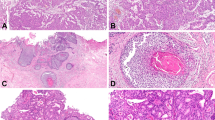Abstract
Urothelial carcinoma in situ (CIS) is a high-grade lesion with different subtypes (large cell pleomorphic (LCP), large cell nonpleomorphic (LC), small cell and clinging (CL)). We explored the frequency of different subtypes in primary CIS and compared different patterns with outcome. We explored whether subtyping of CIS leads to a change in therapy and/or follow-up and should be formally reported. We included 39 patients with a primary CIS and divided them into two groups: one with LPC/LG and one with CL elements. Other subtypes did not exist or occurred only as a mixture. Patient age ranged from 36 to 80 years (mean, 63 years). Twenty had a primary CIS with one single subtype. LCP was predominant with 16 (41 %) cases; the second most important subtype was the CL with four (10 %) cases. Mean follow-up was 26.4 months, (range, 4–100 months). Thirteen patients developed a ≥ pT2 carcinoma. When progression of the different subtypes was examined, no statistical significance was found between mixed forms (p = 0.9437) nor between pure forms (p = 0.744 and p = 0.5955, respectively). Pathologists need not include different subtypes of primary CIS in their report as there is no difference in patient outcomes. It is important to recognize all different subtypes as CIS for best patient treatment.





Similar content being viewed by others
References
Eble JN, Epstein JI, Sesterhenn IA (2004) Who classification of tumors. Tumors of the genitourinary and male genital organs. IARC Press, Lyon
van Rhijn BW, Burger M, Lotan Y, Solsona E, Stief CG, Sylvester RJ, Witjes JA, Zlotta AR (2009) Recurrence and progression of disease in non-muscle-invasive bladder cancer: from epidemiology to treatment strategy. Eur Urol 56:430–442
McKenney JK, Gomez JA, Desai S, Lee MW, Amin MB (2001) Morphologic expressions of urothelial carcinoma in situ: a detailed evaluation of its histologic patterns with emphasis on carcinoma in situ with microinvasion. Am J Surg Pathol 25:356–362
Demir MA, Ryd W, Aldenborg F, Holmang S (2003) Cytopathological expression of different types of urothelial carcinoma in situ in urinary bladder washings. BJU Int 92:906–910
Epstein JI, Amin M, Reuter V (2004) Bladder biopsy interpretation. Lippincott, Philadelphia
Melicow MM (1952) Histological study of vesical urothelium intervening between gross neaoplasms in total cystectomy. J Urol 68:261–279
Sarkis AS, Dalbagni G, Cordon-Cardo C, Melamed J, Zhang ZF, Sheinfeld J, Fair WR, Herr HW, Reuter VE (1994) Association of P53 nuclear overexpression and tumor progression in carcinoma in situ of the bladder. J Urol 152:388–392
Zieger K, Jensen KM (2011) Long-term risk of progression of carcinoma in situ of the bladder and impact of Bacille Calmette-Guérin immunotherapy on the outcome. Scand J Urol Nephrol 45:411–418
Cheng L, Cheville JC, Neumann RM, Leibovich BC, Egan KS, Spotts BE, Bostwick DG (1999) Survival of patients with carcinoma in situ of the urinary bladder. Cancer 85:2469–2474
Norming U, Tribukait B, Gustafson H, Nyman CR, Wang NN, Wijkström H (1992) Deoxyribonucleic acid profile and tumor progression in primary carcinoma in situ of the bladder: a study of 63 patients with grade 3 lesions. J Urol 147:11–15
Horikawa Y, Sugano K, Shigyo M, Yamamoto H, Nakazono M, Fujimoto H, Kanai Y, Hirohashi S, Kakizoe T, Habuchi T, Kato T (2003) Hypermethylation of an E-cadherin (CDH1) promoter region in high grade transitional cell carcinoma of the bladder comprising carcinoma in situ. J Urol 169:1541–1545
Bindels EM, Vermey M, De Both NJ, van der Kwast TH (2001) Influence of the microenvironment on invasiveness of human bladder carcinoma cell lines. Virchows Arch 439:552–559
Patriarca C, Colombo P, Pio Taronna A, Wesseling J, Franchi G, Guddo F, Naspro R, Macchi RM, Giunta P, Di Pasquale M, Parente M, Arizzi C, Roncalli M, Campo B (2009) Cell discohesion and multifocality of carcinoma in situ of the bladder: new insight from the adhesion molecule profile (e-cadherin, Ep-CAM, and MUC1). Int J Surg Pathol 17:99–106
Yamamoto Y, Misumi T, Eguchi S, Chochi Y, Kitahara S, Nakao M, Nagao K, Hara T, Sakano S, Furuya T, Oga A, Kawauchi S, Sasaki K, Matsuyama H (2011) Centrosome amplification as a putative prognostic biomarker for the classification of urothelial carcinomas. Hum Pathol 42:1923–1930
Witjes JA (2003) Bladder carcinoma in situ in 2003: state of the art. Eur Urol 45:142–146
Conflict of interest statement
We declare that we have no conflict of interest.
Author information
Authors and Affiliations
Corresponding author
Rights and permissions
About this article
Cite this article
Compérat, E., Jacquet, SF., Varinot, J. et al. Different subtypes of carcinoma in situ of the bladder do not have a different prognosis. Virchows Arch 462, 343–348 (2013). https://doi.org/10.1007/s00428-013-1378-4
Received:
Revised:
Accepted:
Published:
Issue Date:
DOI: https://doi.org/10.1007/s00428-013-1378-4




